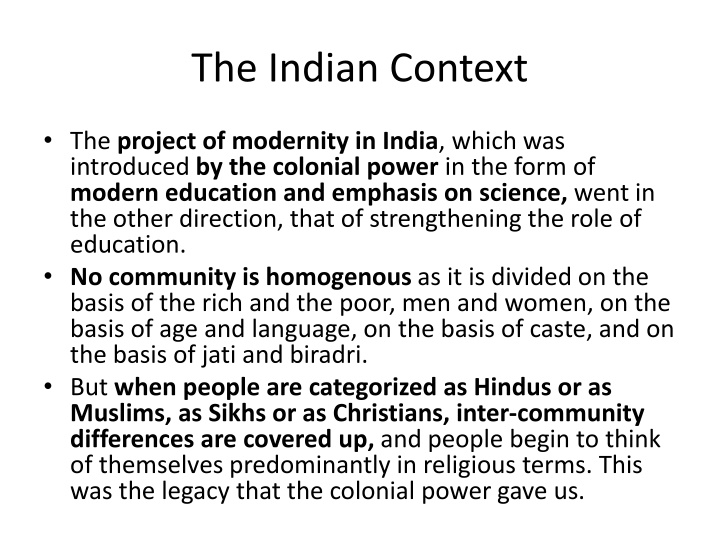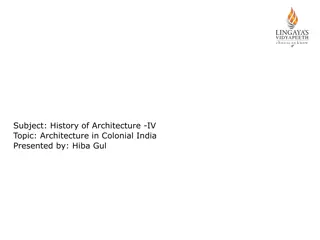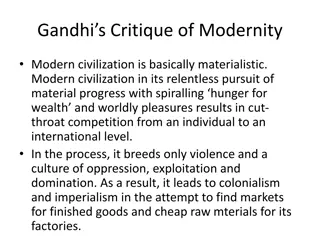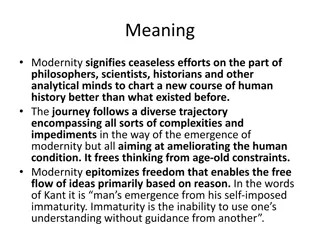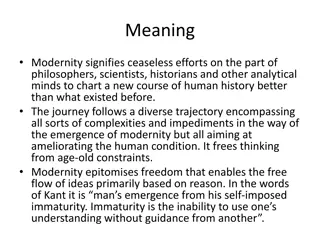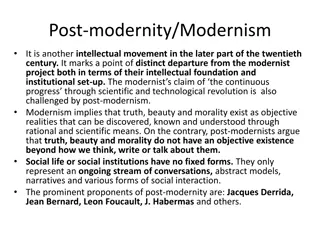The Project of Modernity in India: Colonial Heritage
The project of modernity in India, influenced by colonial powers through modern education and science, took a different path by evolving educational roles.
Download Presentation

Please find below an Image/Link to download the presentation.
The content on the website is provided AS IS for your information and personal use only. It may not be sold, licensed, or shared on other websites without obtaining consent from the author.If you encounter any issues during the download, it is possible that the publisher has removed the file from their server.
You are allowed to download the files provided on this website for personal or commercial use, subject to the condition that they are used lawfully. All files are the property of their respective owners.
The content on the website is provided AS IS for your information and personal use only. It may not be sold, licensed, or shared on other websites without obtaining consent from the author.
E N D
Presentation Transcript
The Indian Context The project of modernity in India, which was introduced by the colonial power in the form of modern education and emphasis on science, went in the other direction, that of strengthening the role of education. No community is homogenous as it is divided on the basis of the rich and the poor, men and women, on the basis of age and language, on the basis of caste, and on the basis of jati and biradri. But when people are categorized as Hindus or as Muslims, as Sikhs or as Christians, inter-community differences are covered up, and people begin to think of themselves predominantly in religious terms. This was the legacy that the colonial power gave us.
Colonization of the Mind Colonialism is much more than political domination by another country, or economic exploitation of the labour, the resources, and the markets of one country by another. Colonization in India, as elsewhere, involved the colonization of the mind, through the interpretation of our histories, our languages, our traditions, our literatures, and through placing people in discrete categories. Colonized people simply lose control over their own shared histories and traditions, and come to understand themselves and their pasts in the terms coined by the colonial power. This form of soft power is dangerous simply because it is lasting.
Polarization and Communal Organizations The categories created by the British government through the politics of ethnic mapping were internalized by the colonized. Second, the Indian people were polarized with the arrival of communal organizations onto the political scene in the form of the Hindu Mahasabha and the Muslim League. Looking at the hold of religion on politics and on the collective mind, some scholars like Prof T.N.Madan have suggested that secularism is an alien concept for India, simply because the Indian society has not been secularized, or that people continue to be religious.
Utility of Secularism in India But the utility of secularism is justified in India precisely because people are religious. Secularism is meant to regulate relations between the State and various religious groups on the principle of equality, on the principle that the State will not discriminate against one religion. The minority needs to be assured that it will not be discriminated against even though it is in a minority. So the answer to communal tension is not to abandon secularism, but to deepen it.
The Gandhian Perspective In an attempt to build a cross-community alliance, Gandhiji looked for a principle that could bind together people who subscribed to different faiths; a principle which weld them into a mass movement (Civic Nationalism of Gandhi). More importantly, this principle had to reassure minority groups that they would not be discriminated against, as much as it had to warn the majority that majority rule is not the right path to democracy, which is built upon the twin principles of freedom and equality for all. Gandhiji found this particular principle in the doctrine of sarva dharma sambhava, which can be read as equality of all religions or that all religions should be treated equally.
The Gandhian Perspective (contd.) Sarva dharma sambhava was not only a political principle designed to bring people together, it was also a normative principle that recognized the value of religion in people s lives. It was democracy and justice, and the rights to freedom and equality that the anti-colonial struggle was fighting for. Gandhian struggle was not only fighting for independence from the British but also struggling to establish justice and democracy in the country. And, the principle of democracy dictated equality of all religions.
Nehruvian Perspective of Dharma Nirpekshata Nehru was profoundly uneasy with the kind of political passions that religious identities had the power to evoke. Nehru s preferred notion of secularism was that of dharma nirpekshata or that the state would not be influenced by religious considerations in enacting a policy. But Nehru could not continue to believe that the domain of policy making could be separated or abstracted from that of religion, or indeed that religion could be banished from the political and the public sphere, for long. So Nehru was, reluctantly, forced to come to terms with and his understanding of secularism came closer to the notion of sarva dharma sambhava.
Features of Nehruvian Secularism First, secularism did not mean a state where religion as such is discouraged. It means freedom of religion and conscience, including freedom for those who may have no religion. Second, for Nehru the word secular was not opposed to religion. It is a state which honours all faiths equally and gives them equal opportunities. As a state, it does not allow itself to be attached to one faith or religion, which then becomes the state religion.
Features of Nehruvian Secularism (contd.) To sum up, Nehruvian concept of the secular state carried three meanings: i. Freedom of religion or irreligion for all, ii. The state will honour all faiths equally and discriminate against none, and iii. That the state shall not be attached to one faith or religion (state religion). In effect, the meaning that secularism acquired in the Indian context, added one more dimension to its general concept; it also assured equal treatment of all faiths.
Secularism: A Positive Concept This theme was echoed by Justice Reddy, who underlines the point by declaring, Secularism is more than a passive attitude of religious tolerance. It is a positive concept of equal treatment of all religions. Secularism, ruled Justice Sawant, was part of the basic structure and the soul of the Constitution, and it could not be infringed in any way.
